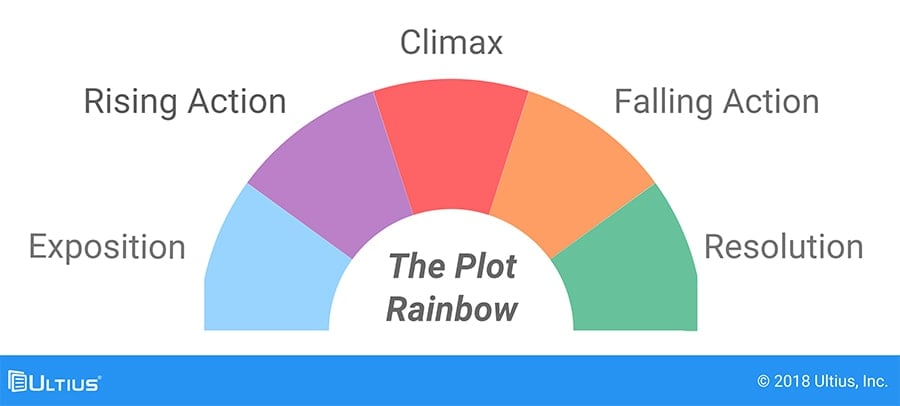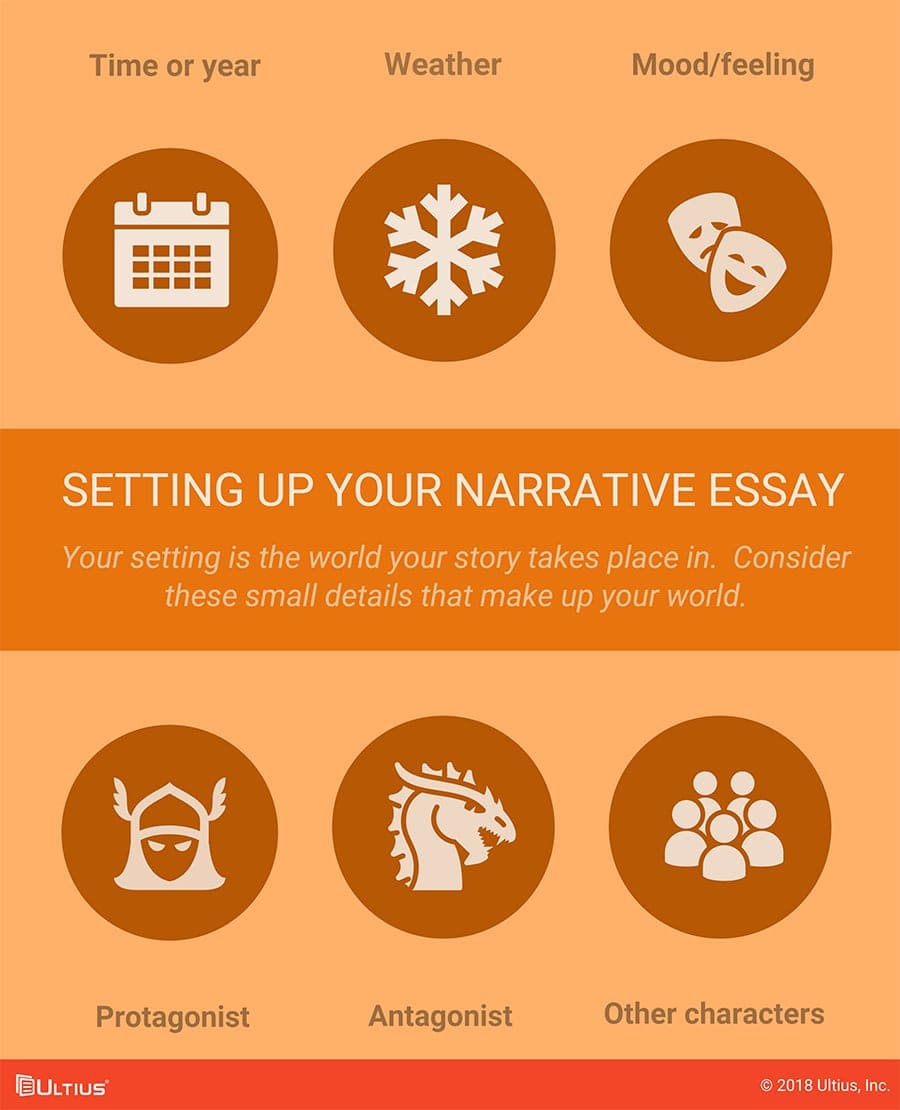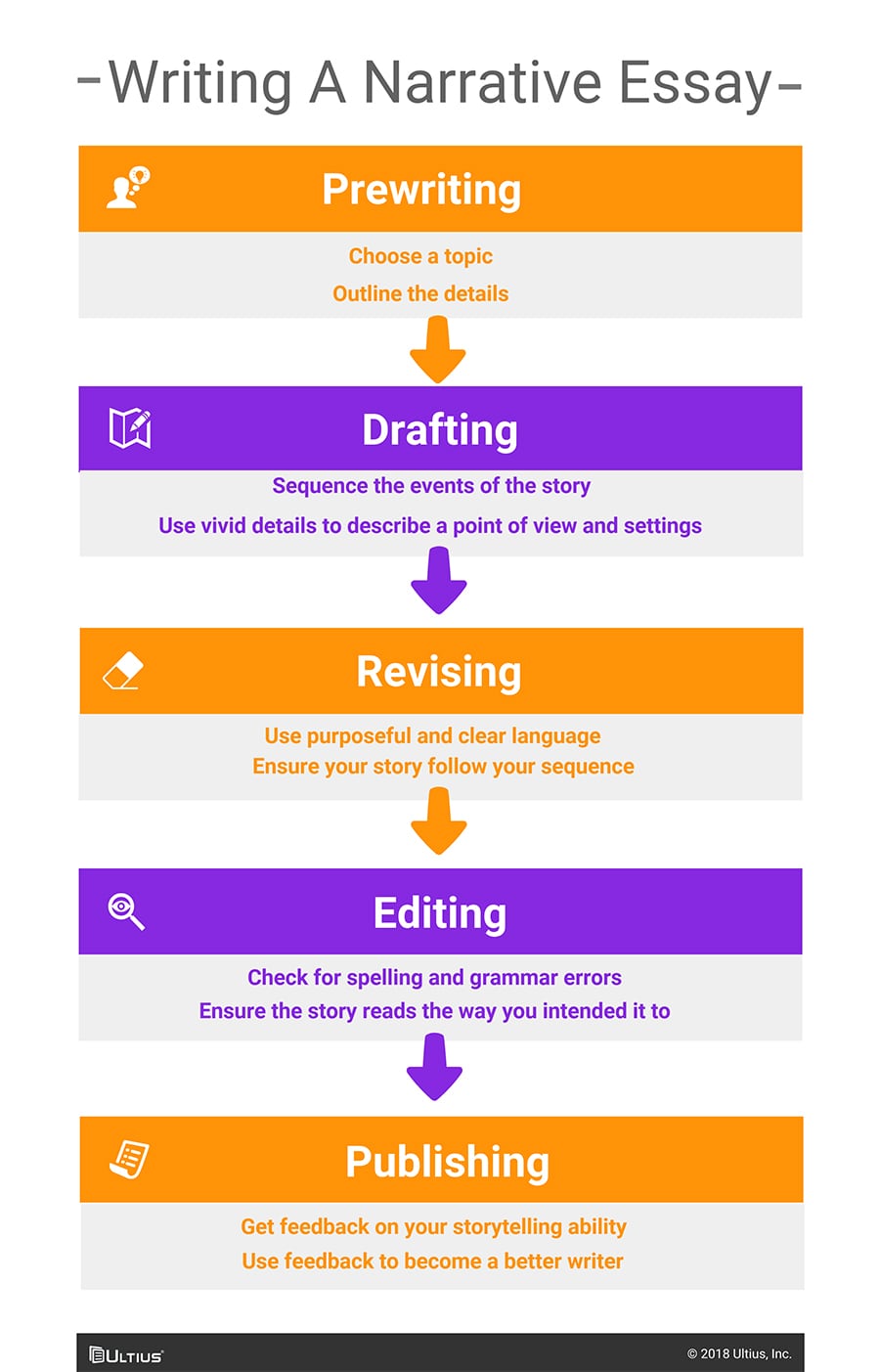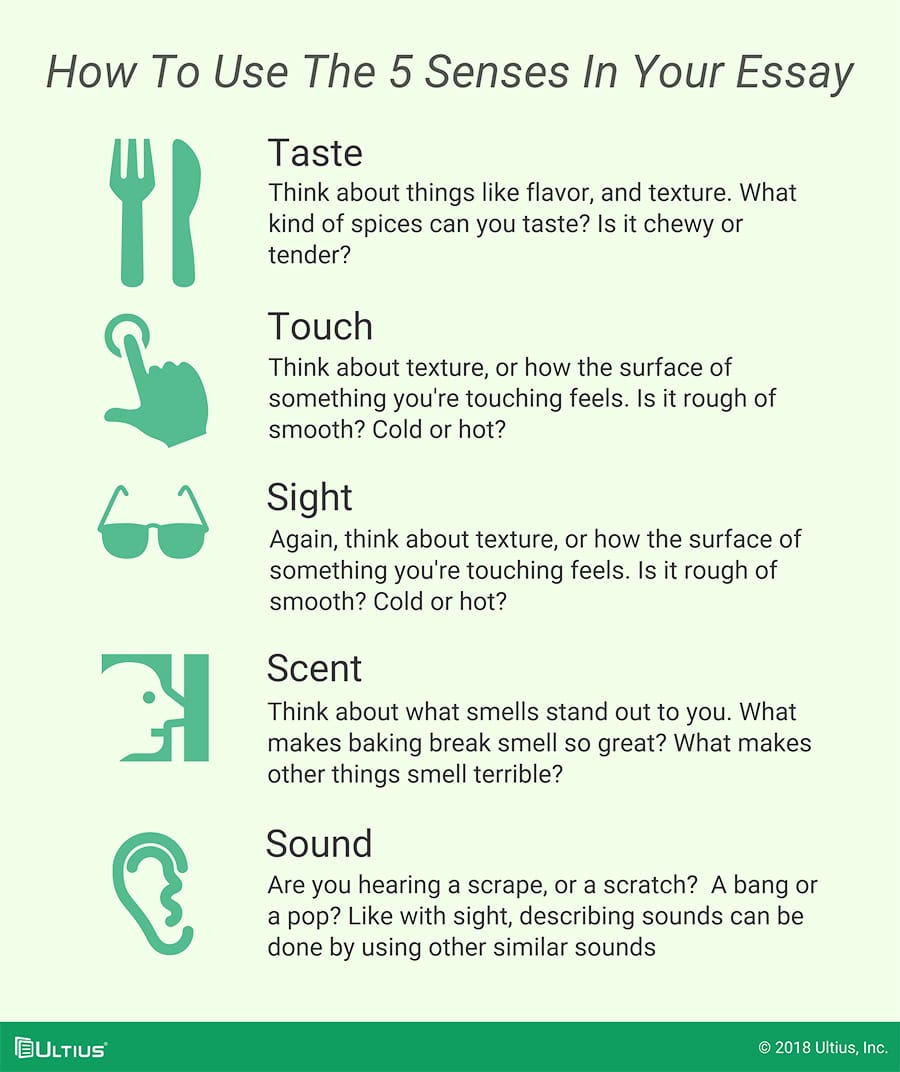How to Write a Narrative Essay
Crafting a perfect narrative essay—the ultimate guide
Writing a great narrative essay for college is easy as long as you follow the normal plot rainbow (narrative arc) of exposition, rising action, climax, and closure. Make sure to use strong imagery in your wording and remember that you are telling a story, so ensure it’s interesting for the reader.
While you probably gained some experience in writing essays when you were in high school, college is a time when you will be expected to write several kinds of essays that you have not encountered before. The narrative essay is one such kind of essay.
The purpose of this guide from Ultius is to provide you with comprehensive information on how to go about writing a narrative essay. The guide will contain the following sections:
- Purpose of a narrative essay
- The concept of narrative
- Elements of a good narrative essay
- How to write a great narrative essay
- Samples/examples
- Additional information
By the time you are done reading this guide, you should have a solid idea of how to write a narrative essay, as well as resources you can use in order to help with writing that.
Purpose of a narrative essay
Narrative essentially means story, and the fundamental purpose of a narrative essay is to tell a story to the reader. You, the writer, must come up with an idea for the story, and then you must write it in vivid and captivating terms. A narrative essay is not like many other forms of essays in that it relies far more on imagination than reason. In this sense, for example, a narrative essay is quite different from an argumentative or persuasive essay.
Avoid arguments or persuasion when writing a narrative essay
One should carefully understand and study the core differences between narrative and other kinds of essays in order to get a firm understanding of the purpose.
| Narrative essay | Argumentative essay | |
| Purpose | to tell a story | to make an argument |
| Main mode | imaginative | rational |
| Example of a claim | "I ate what was perhaps the most delicious snow cone of my life." | "People should avoid eating snow cones because they have too much sugar." |
| Style | First-person, emotive, vivid, subjective | Third-person, analytical, precise, objective |
| Examples of publications | some columns in The New Yorker and Current Affairs | political magazines, ethnographies |
Important note: A narrative essay is not quite the same thing as a short story. This is because the narrative essay, still being a form of essay, is non-fictional. That is, the writer is generally expected to write about an experience that actually happened. If the story were fictional, then this would no longer be a narrative essay but rather a short story.
Related how-to guide—How to write a persuasive essay.
The importance of narrative essays (especially when you’re in college)
In general, people bond by telling each other stories, and it is through listening to stories that people develop empathy for each other and learn to see the world through another person's eyes. In fact, according to one study reported in Scientific American, it was found that reading literature helped subjects develop stronger empathy and the ability to read the emotional states of others in real life. These skills were gained as a result of reading literary works with a strong narrative element (such as Hamlet or others).
Writing a good narrative essay can enable you to share your experiences with others in a powerful way. This can persuade people to want to see the world you see it (because they find it intriguing and/or beautiful), and it can also inspire them to be more passionate and creative in the way that they experience their own lives. The narrative essay is a vehicle for sharing the world according to you with others.
The concept of narrative
The central core of the narrative essay is, of course, the story itself. It is important that you tell your story in a way that is compelling to other people. Even if you have a great idea in your head, execution is everything when it comes to storytelling (as most of us have probably found out the hard way in real life).
If you don't tell your story well, then no one is going to bother to listen, even if the main idea is interesting.
According to the Ultius glossary, a narrative story is one that is based on a person’s experiences and is intended to tell a story that follows the same lifecycle as human life (start to end).
People have been telling and writing stories for a long time, and there are some key elements that have been built up around the concept of narrative. One of the main elements that is worth discussing here is the narrative arc.
Following the narrative ‘arc’
In its standard form, the narrative arc has five main phases:
- 1. exposition
- 2. rising action
- 3. climax
- 4. falling action
- 5. denouement (resolution)
In literary theory, this is called Freytag's pyramid, named after Gustav Freytag, who is the person who first described this format. Most compelling stories start with the first phase and end with the fifth phase, passing through the other phases on the way.
Here are the descriptions of the five main phases of the standard narrative arc.
| Phase | Description | Example |
| Exposition | introduce the situation, provide background information | "It was Friday evening, and I was going to the bar with my brother for his birthday." |
| Rising action | have the situation develop and progress toward the main focus of the story | "When we got to the bar, we found out it was karaoke night, and all our friends pressured my brother to sing a song." |
| Climax | the main event and emotional high point of your story | "My brother picked an old favorite, and everyone sang along." |
| Falling action | describe the aftermath of the climax | "All our friends were energized, and we proceeded to relax and have a lot of beers." |
| Denouement | tie up loose ends and bring the story to a close | "The next day, my brother was hungover, and he was pretty embarrassed when he saw a video of himself singing." |
This pyramid is also similar to the concept of a plot rainbow (shown below):
Not all parts of the plot rainbow are required for a good narrative essay, but they are usually included in some capacity. Just make sure to include the most basic elements and avoid using an anticlimax (especially if you’re just learning how to write a narrative essay for college).
An anticlimax is when the author builds up the narrative arc but then disappoints the reader with the opposite of a climax (a real let down). Read more about how to avoid anticlimaxes.
In summary, you should ensure that your narrative essay is interesting by including the basic elements of the plot rainbow and avoid letting the reader down with an uninteresting climax.
The formal elements of narrative
Aside from the narrative arc, you should also pay attention to the formal elements of narrative. There are four important ones to keep in mind:
- 1. plot
- 2. character
- 3. setting
- 4. theme
Plot refers to the actual story that is being told. In order to develop an effective plot, you should follow the narrative arc described above in the discussion of Freytag's pyramid. That is a structure that has been tried and tested over a very long time, and it is generally a good format for delivering an emotionally satisfying experience to the reader.
Character refers to the people who are part of your story. In general, there is one main character and a few to several supporting characters. It is important to ensure that every character in your narrative essay contributes to the overall plot. In other words, care should be taken to not overpopulate your story, which can become distracting for the reader.
Setting refers to the actual location (in time and space) that your story is taking place. This is fairly self-explanatory.
Theme refers to the overarching message or driving ideas behind your story. Why have you chosen to tell this particular story in your narrative essay, and what would you like your reader to get from reading the story? If a story doesn't have a strong theme, then it can feel random, which would leave the reader confused and not sure why he bothered reading it. While this may not sound significant for a regular college class, it could be the difference between getting a scholarship or not (click here to learn how to write a scholarship essay).
Here is a summary of each core element you want to use.
| Element | Description | Example |
| plot | the actual story of what happens | going to the bar for your brother's birthday |
| character | the people in the story | you, your brother, some other friends |
| setting | where and when the story happens | the local bar, the night of your brother's birthday |
| theme | the meaning or underlying idea of the story | lighthearted: just sharing a fun time to make people laugh |
A note about using time
In terms of setting, the simplest way to write a narrative essay is to proceed in a linear way. This means that your story should start at one point in time, and then it should proceed forward through time until it reaches its conclusion.
In some forms of more experimental storytelling, writers jump around in time, using techniques such as flashbacks and stream of consciousness. Unless you are very good at using such techniques, though, there's a huge risk that your story will just fall apart. Anyway, such techniques are much more complex than what is generally required from a standard narrative essay. So, you should probably just stick to the linear time format.
If you are just learning how to produce a narrative essay, avoid the complex techniques of parallel or inconsistent time settings. You will get there, but know that it is confusing to readers if you don’t master the basics first.
Elements of a good narrative essay
There are certain key elements that will be included in every good narrative essay. We will now share these secrets of the craft with you.
Use a strong voice
One of the best ways to draw your reader into your narrative essay is to develop and utilize a strong voice. In writing, voice refers to the way you express specific things, the sentence structures you use, the different parts of speech, and so on. Everyone knows that there's a difference between reading a thriller and an instruction manual—and that difference has everything to do with voice.
Imagery in your vocabulary paints a picture for the reader so they can put themselves in the setting or situation. Use descriptive language to foster strong imagery.
One way to develop strong voice is to use effective vocabulary and strong modifiers. Vocabulary refers to the range of words at your disposal: the broader your vocabulary, the more able you will be to find the perfect words for the situation you are describing.
Modifiers refer to adjectives and adverbs that add meaning nouns and verbs, respectively. Modifiers can be powerful tools, but in general, you do not want to overuse them, and it is often better to just find a stronger noun or verb if one is available.
Parts of speech and vocabulary
The table below is an example of how the effective use of parts of speech and vocabulary can do a lot to change your voice.
| Part of speech | Example | Full phrase |
| adjective | medium-sized | the medium-sized dog |
| verb | ran | the medium-sized dog ran |
| adverb | happily | the medium-sized dog happily ran |
| stronger verb | pranced | the medium-sized dog pranced |
| stronger noun | collie | the collie pranced |
There is no hard and fast rule about which specific voice is "better." However, most writers and readers would probably agree that "the collie pranced" is more compelling and effective than "the medium-sized dog happily ran". This is an example of how voice can seriously affect the quality of a narrative essay.
Feeling overwhelmed? Essay writing services from Ultius can help you get a custom document written from a professional writer.
Use a consistent point of view
Point of view refers to the perspective from which a story is being told. For narrative essays, the point of view is almost always first person: the writer speaks in his own voice, using "I" statements. This also means, though, that the writer should not include anything that he could not have known or seen for himself within the story, unless an explanation is given for how he knew or saw it. This is an example of what it means to keep the point of view consistent.
| Point of view | Focus | Example |
| first person | I | "I went to class today." |
| second person | you | "You went to class today." |
| third person limited | he/she (specific—like following a person around) | "He went to class today." |
| third person omniscient | he/she (anyone—the narrator can know anything) | "In the meanwhile, on the other side of the planet, someone went to class." |
Use a coherent narrative arc in your essay
Finally, a strong writer (like the writers for Ultius who produce purchased narrative essays) will always adhere to a coherent narrative arc. The specifics of the narrative arc have been developed above. While a narrative essay theoretically could be good without following that arc, that is quite rare, and it is nearly impossible to achieve if you are a beginner or do not have a very strong grasp of what you're doing.
For practical purposes, then, we can just say that a strong narrative essay adheres to the traditional narrative arc. This means that the story starts at a certain point in time, ends at a later point in time, builds up to a climax from the beginning, and then builds down from the climax toward the end. Attention should also be dedicated to ensuring that all of the formal elements of narrative are in order.
How to write a great narrative essay
There are some things you can do in order to ensure that your narrative essay turns out fully baked. Here are a few of those things.
Plan your narrative arc before you jump in
While also true of any essay, in the narrative essay it’s even more important: it is much easier to stay on track and nail all the crucial elements of the narrative essay if you have a game plan in mind before actually writing it. The narrative arc provides good framework for you to plan your outline.
Example outline of a narrative essay
Below is an outline modeled on the phases of the narrative arc.
I. Exposition (including a hook)
- A. It was my brother's birthday and a Friday evening: we all knew what that meant.
- B. It was time to go celebrate at the bar.
II. Rising action
- A. We called an Uber to make sure driving that night was out of the picture.
- B. At about 9 PM, we arrived at the local bar and ran into several of our friends.
- C. It was karaoke night, and our friends demanded that my brother sing a song.
III. Climax
- A. A. My brother picked a crowd pleaser of a song and sang at the top of his lungs.
IV. Falling action
- A. Everyone laughed and told him he sounded terrible but great at the same time.
- B. We continued drinking beers until closing time.
V. Denouement
- A. My brother was hungover in the morning, and he was embarrassed (but in a good way) when he saw a video of himself singing karaoke.
Make sure the assignment actually is a narrative essay
This may sound like strange advice, but bear with us for a moment. Many college students who are new to writing academic essays (and need writing help from professional essay writers) may think that all essays are narrative essays, and they are thus in for a rude shock.
If your professor actually wants an analytical essay or an expository essay and you write a narrative essay instead, then you will almost definitely get a failing grade.
The other way around, a narrative essay is not like other academic essays: with the narrative essay, you are supposed to appeal to imagination more than reason, and to tell a strong story using your own subjective, personal voice. So, you should make sure that the assignment in front of you actually is a narrative essay, and then you should make sure you treat it as a narrative essay and not like any other kind of essay.
Vocabulary and sentence structure count for a lot
The difference between great writing and mediocre or bad writing often comes down to vocabulary and sentence structure. In order to write a great narrative essay for your college class, you should have various possibilities in this regard at your disposal, and you should know when to use the right ones.
For example, adverbs (such as "swimmingly" and most other -ly words) can be used to great effect, but if you use them too much or too often, then your writing can seem sloppy or lazy. Likewise, there is a time for simple, direct sentences, and there is a time for more complex sentences—and a lot of narrative effect can come from changing up sentence structure. This can help avoid monotony and thus keep your reader interested.
| Type | Description | Example |
| simple sentence | one independent clause | "I went to class." |
| compound sentence | two independent clauses | "I went to class, but then I remembered that today is a holiday." |
| complex sentence | independent clause plus dependent clause | "Before calling my girlfriend, I read some Ultius reviews online." |
| compound-complex sentence | two independent clauses plus dependent clause | "Before calling my girlfriend, I went to class—but then I remembered that today is a holiday." |
The types of sentences you will want to use will depend on the kinds of effects you want to have on the reader. For example, compound-complex sentences are often more elegant and flowing, whereas simple sentences are short and blunt. Either one could work depending on what you are trying to do.
Great narrative essays use vivid language that evoke the senses
It was mentioned before, and it’s worth mentioning again—great story-based writing for college requires imagery.
If you follow the infographic above, you will see that you have a plethora of options for describing the things you talk about in your narrative essay.
A sample narrative essay
The following sample narrative essay on birthday nostalgia follows the narrative arc and includes footnotes to highlight the major components involved. Go through the document and focus on how the story follows a natural progression.
Feel free to download the sample and use it for your own purposes if you are not interested in using Ultius writing services to have one produced for you.
Final thoughts and considerations before you write your own narrative essay
We have now arrived at the end of this guide, and we hope that you now have a much better idea of how to write a narrative essay. Here is a summary of some key points from this guide for your reference.
1. Adhere to the narrative arc
The standard narrative arc should be the foundation of your narrative essay. It is tried and true: it works.
2. Use excellent vocabulary and parts of speech
In order to make your narrative essay excellent, you need to use the right words and modifiers at the right times. This is true of sentence structure as well.
3. Pay attention to the formal elements of narrative
You want to develop a tight and coherent plot, include the relevant characters (and cut the others), move forward in time, and have a clear idea behind the story you are telling.
4. Use additional resources if you need them
Ultius has several resources, including glossaries and document-specific writing guides, that can help you write a great narrative essay. Please don't hesitate to look into them on our website.
Stuck with writing?
Ultius can help







